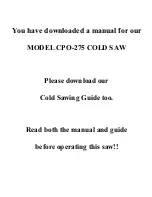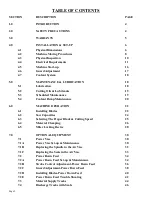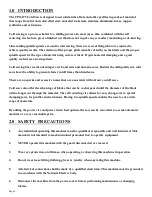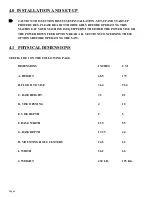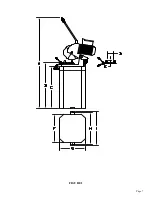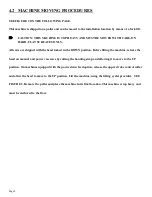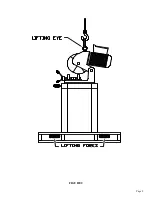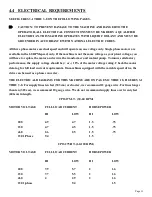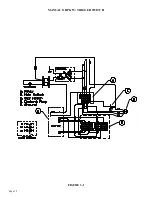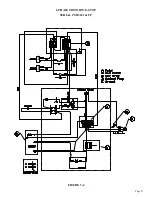
Page 4
1.0 INTRODUCTION
The CPO-275 Cold Saw is designed to cut solids, tubes, flats and other profiles in grades of material
that range from hot and cold rolled steel, annealed tool steels, stainless, aluminum, brass, copper,
synthetics and extrusions.
Cold sawing is a process similar to a milling process. In most cases, this, combined with the self
centering vise feature, gives a finished cut that does not require any secondary machining or de-burring.
Since milling spindle speeds are used in cold sawing, there are several things that are required to
achieve quality results. The selection of the proper pitch (number of teeth) on the blade and the proper
spindle speed for the type of material being cut are critical. Proper material clamping and a good
quality coolant are also important.
Cold sawing has several advantages over band saws and abrasive saws. Besides the mill quality cut, cold
saws have the ability to generate faster cutoff times than band saws.
There are no sparks and excessive noises that are associated with abrasive cutoff saws.
Cold saws also offer the advantage of blades that can be re-sharpened until the diameter of the blade
will no longer cut through the material. The self centering vise allows for easy changeover to special
clamping jaws, for profiles and extrusions. Having two spindle speeds enables the user to cut a wide
range of materials.
By adding the power vise and power down feed options, the saw can be converted to a semi-automatic
machine at a very reasonable price.
2.0 SAFETY PRECAUTIONS
1.
Any individual operating this machine must be qualified, responsible and well instructed. This
manual is not intended to teach untrained personnel how to operate equipment.
2.
NEVER operate this machine with the guard disconnected or removed.
3.
Wear eye protection, at all times, when operating or observing this machine in operation.
4.
Do not wear loose fitting clothing, gloves or jewelry when operating this machine.
5.
All electrical connections shall be made by a qualified electrician. This machine must be grounded
in accordance with the National Electric Code.
6.
Disconnect the machine from the power source before performing maintenance or changing
blades.
Summary of Contents for CPO-275
Page 8: ...Page 7 FIGURE 1...
Page 10: ...Page 9 FIGURE 2...
Page 13: ...Page 12 MANUAL OR PK W TRIGGER SWITCH FIGURE 3 1...
Page 14: ...Page 13 PKPD W EMERGENCY STOP FIGURE 3 2...
Page 15: ...Page 14 1 PHASE MOTOR W TRIGGER SWITCH FIGURE 3 3...
Page 16: ...Page 15 1 PHASE MOTOR W E STOP SERIAL S B3431 UP FIGURE 3 4...
Page 22: ...Page 21 FIGURE 5A...
Page 28: ...Page 27 FIGURE 8 FIGURE 9...
Page 30: ...Page 29 FIGURE 10...
Page 36: ...FIGURE 14 Page 35 C A B D...
Page 38: ...Page 37 FIGURE 15...
Page 40: ...Page 39 FIGURE 16...
Page 42: ...Page 41 FIGURE 17...
Page 44: ...Page 43 FIGURE 18...
Page 46: ...Page 45 FIGURE 19...
Page 48: ...Page 47 FIGURE 20...
Page 50: ...Page 49 FIGURE 20A...
Page 58: ...Page 57 FIGURE 23...
Page 60: ...FIGURE 24 Page 59...
Page 62: ...Page 61 G 078000 60 RPM 230 Volt 1 Phase T S 078001 60 RPM 230 Volt 1 Phase E S FIGURE 25...
Page 66: ...Page 65 FIGURE 27...
Page 68: ...Page 67 FIGURE 28...
Page 70: ...Page 69 FIGURE 29...
Page 74: ...Page 73 FIGURE 31...
Page 76: ...Page 75 FIGURE 32...
Page 78: ...Page 77 FIGURE 33...
Page 80: ...FIGURE 34 Page 79...
Page 82: ...Page 81 FIGURE 35...
Page 84: ...Page 83 FIGURE 36...
Page 86: ...Page 85 FIGURE 37...
Page 88: ...Page 87 FIGURE 38...
Page 90: ...Page 89 FIGURE 39...

